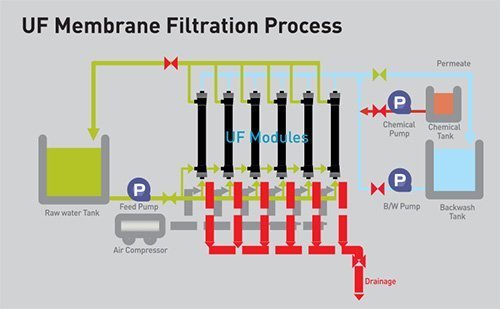Ultra Filtration Systems
Product Info
Ultrafiltration is a separation process using membranes with pore sizes in the range of 0.1 to 0.001 micron.
Typically, ultrafiltration will remove high molecular-weight substances, colloidal materials, and organic and inorganic polymeric molecules. Low molecular-weight organics and ions such as sodium, calcium, magnesium chloride, and sulfate are no removed.
Because only high-molecular weight species are removed, the osmotic pressure differential across the membrane surface is negligible. Low applied pressures are therefore sufficient to achieve high flux rates from an utrafiltration membrane.
Ultrafiltration membranes can have extremely high fluxes but in most practical applications the flux varies between 50 and 200 GFD at an operating pressure of about 50 psig in contrast, reverse osmosis membranes only produce between 10 to 30 GFD at 200 to 400 psig.
Ultrafiltration, like reverse osmosis, is a cross-flow separation process. Here liquid stream to be treated (feed) flows tangentially along the membrane surface, thereby producing two stream. The stream of liquid that comes through the permeate will depend on the characteristics of the membrane, the operating conditions, and the quality of feed. The other liquid stream is called concentrate and gets progressively concentrated in those species removed by the membrane. In cross-flow sepration, therefore, the membrane itself does not act as a collector of icons, molecules, or colloids but merely as a barrier to these species.



Specifications of Membrane
| Classification | (UF-S) |
|---|---|
| Shape | Hollow-Fiber |
| Material | PVDF |
| Nominel MWCO | 100-150 kDs |
| DD/ID | 1.3/0.7 mm |
| Flow Direction | Outside-to-Inside |
| Pure water Flux (at 100 kPa, 25 C) | 500 LMH |
| Classification | (UF-F) |
|---|---|
| Shape | Hollow-Fiber |
| Material | PVDF |
| Nominel MWCO | 0.07µm |
| DD/ID | 1.3/0.7 mm |
| Flow Direction | Outside-to-Inside |
| Pure water Flux (at 100 kPa, 25 C) | 700 LMH |
High Performance Filters
ULTRA FILTERS are designed with inside-out flow configuration, the inside surface of the capillary membrane remain completely clean during the manufacturing process, providing uniform fibre structure, defect free, low foulding tendency, robustness and high surface integrity throughtout the fibre.
